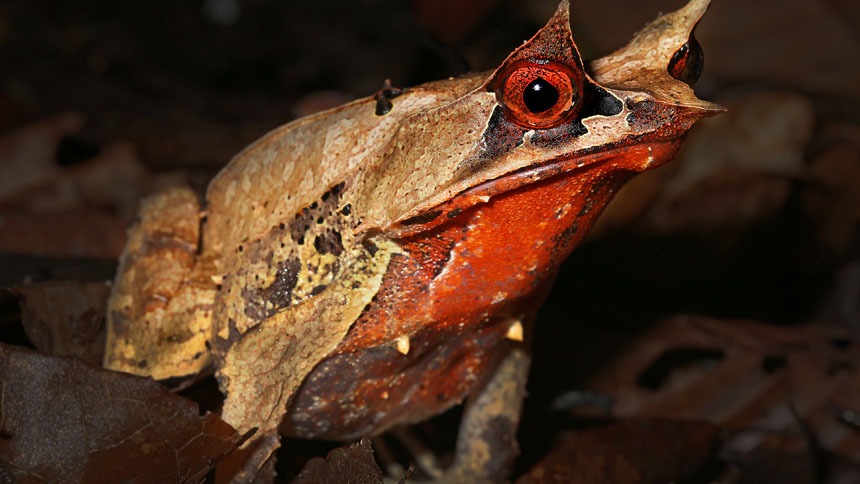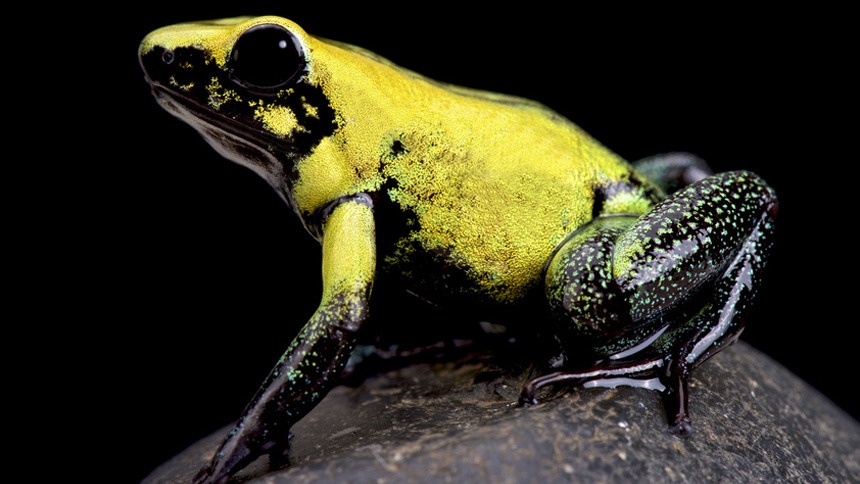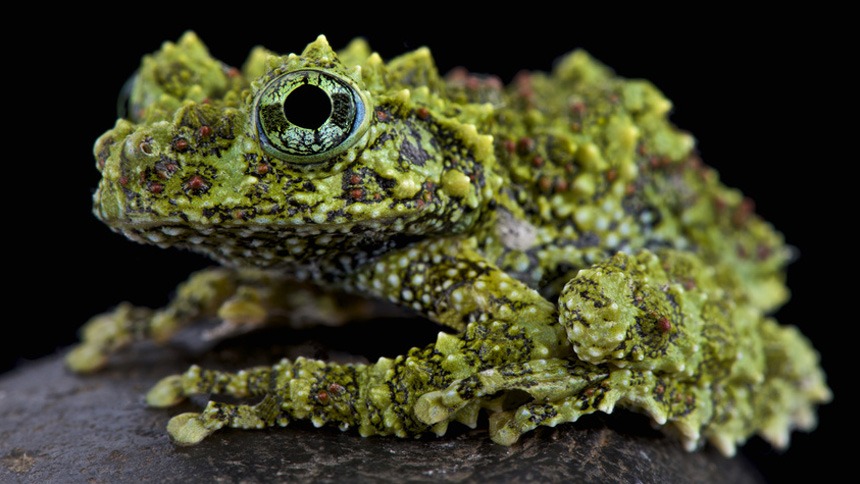
10 Ways Frogs Defend Themselves Against Predators
Frogs and Toads use many different self-defense mechanisms to protect themselves from predators. They can jump away, play dead, urinate, hide in their environment, and more.
In this blog post, I will go over the 10 most common defense mechanisms that frogs use to survive.
Page Contents
1. Frogs Use Their Vocal Sacks To Appear Larger
Frogs use their vocal sacks to amplify sound and appear larger than they really are
They have a deep, resonating chamber called a vocal sack that they use to produce sound. The type of frog varies in how it uses this vocal sack for defense, but all frogs have the same goal-to be heard!
Frogs may also puff up their bodies with air to look much bigger than they truly are and intimidate predators. This can help them look more aggressive or too big for predators to eat. This can surprise an enemy and deter them from attacking.
2. Anurans (Frogs and Toads) Urinate to Deter Predators
Did you know that frogs and toads sometimes urinate as a self-defense mechanism? It’s true! Frogs and toads release their urine when they are stressed, afraid, or want to fend off a predator.
The bad news is that this can happen to you if you handle them incorrectly. Regardless, this defense is sometimes enough to cause a predator to release the frog or toad when it begins urinating.
3. Their Bright Colors Serve as a Defense Mechanism

When it comes to defending themselves, frogs have a few tricks up their sleeves. Some of these defenses are obvious – such as the bright colors. Others are a little more subtle, like blending in with their surroundings.
Flash coloration is one of the more obvious methods that frogs use to defend themselves. This involves displaying bright colors to confuse, distract, and frighten predators. For instance, the Red-Eyed Tree Frog flashes its red eyes to scare away potential attackers.
Another common defense mechanism is protective coloration. This involves camouflage, helping the frog blend in with its surroundings and making it harder for predators to spot them.
There are also frogs that use warning coloration to express their toxicity. This is the opposite of aposematism, which warns predators that they are poisonous and not to be eaten. Many frogs from South America are extremely colorful with bright blue, red, or yellow bodies indicating that they are highly poisonous.
With all these tricks up their sleeves, hopefully, this makes you appreciate these little guys even more.
4. They Mimicry to Scare Off Predators
Did you know that some frogs use mimicry to scare predators? Sudden unexpected movement is sometimes a good way for frogs to startle a predator and scare it away.
- Some frogs have hidden colored spots in the folds of their skin or on their bellies which look like eyes to predators.
- If it gets too close, a frog may suddenly raise to reveal the fake eyes on its belly and alarm a predator.
- Some species will jump or vigorously dance by moving their legs left and right to catch a predator off guard.
The Congolese giant toad is a large, brown toad found in the rainforests of Africa. This toad has an interesting defense mechanism – it mimics the gaboon viper as self-defense.
The gaboon viper is a venomous snake that is deadly to many animals. When a predator sees the Congolese giant toad, it mistakes it for the gaboon viper and runs away in fear.
This toad has evolved over time to look so much like the gaboon viper that even experts have trouble telling them apart.
5. Frogs Jump Away From Their Predators
Did you know that frogs have some amazing defense mechanisms? Some frog species can jump really high, while others can swim away quickly.
American bullfrogs, for example, can leap over 7 feet in a single bound! And the South African Sharp-Nosed Frog holds the Guinness World Record for the longest jump by a frog – it can leap up to 17.6 feet!
After all, a frog that sees incoming danger is relatively safe because it’s nearly impossible to catch them!
6. They’re Poisonous to Some Predators
Did you know that some frogs are poisonous? Poison Dart Frogs in particular use bright colors to warn predators of their toxicity.
Frogs with poisonous glands can cover themselves in a sticky toxic coating which can make the predator spit them out or die if they do wind up in their mouth. Depending on the species, frog poison can burn, paralyze, cause respiratory issues, hallucinations, convulsions, or even death.
Poisonous frogs can be very dangerous to humans and pets, so it’s important to keep your distance if you are unsure if the species is safe to handle.
7. Some Frogs Squeel to Scare Away Predators
Have you heard the frogs screaming in your backyard? What are they doing? Chances are, they’re trying to scare away predators.
The Desert Rain Frog (Pseudacris cadaverina) is one of these tiny creatures, but its squeak sounds more like a dog’s toy squeak than something that could be intimidating. However, it must mean that this technique works because the little guy has been around for quite some time now!
8. Frogs Camouflage and Hide

In the animal kingdom, there are many creatures that have mastered the art of camouflage. Frogs, in particular, are experts at hiding from predators.
There are many different types of frogs, and many of them can adapt the color of their skin to match their surroundings. Other frogs are naturally the same colors as their environment. One particularly amazing example of frog camouflage is the mossy tree frog.
Mossy tree frogs live in areas near rivers and streams. They are very good at hiding in the trees, under leaves, and blending in with moss, where they are nearly impossible to see.
9. Some Play Dead to Avoid Predators
Did you know that frogs can play dead to avoid being eaten by predators? It’s an old trick, but it still works! Frogs will remain completely still and often lay on their backs with their palms faced up.
This is one of the oldest self-defense mechanisms in the book, and it’s a way for frogs to avoid being eaten. But what happens if a frog plays dead for too long?
The main danger of playing dead occurs when the frog’s silence and stillness are taken for death and the frog is either picked up or stepped on. If this happens, the frog has to immediately jump away and try to escape before it’s too late.
Playing dead is an effective way for frogs to avoid being eaten.
10. They Use Their Environment to Escape
Did you know that frogs use their environment to escape from their predators? It’s true! Some frogs will burrow into the soil using their back legs to dig in order to hide from predators. Others, mostly semi-aquatic frogs, dive into the water in order to escape incoming predators.
Frogs swim by using their hind legs to push off from the bottom and their front legs to steer.
Conclusion
Frogs are some of the most well-adapted creatures in the animal kingdom. They have mastered the art of camouflage and can jump, swim, and play dead to avoid being eaten by predators.
Frogs also use their environment to escape from danger. With all these amazing defense mechanisms at their disposal, it’s no wonder that they are one of the most successful groups of animals on Earth!
Want to learn more? Learn about the different types of predators of frogs.

Leave a Reply